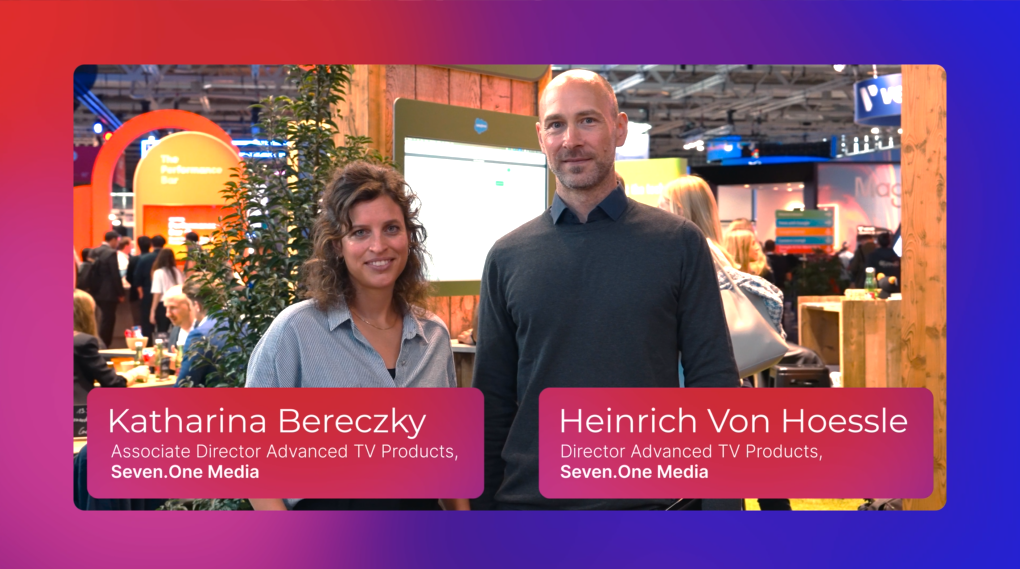

Post-cookie prospecting playbook
Our playbook breaks down the current options available to brands for targeting audiences on the open web — and how they stack up when it comes to reaching net new customers.

Data collaboration is increasingly essential for organizations seeking to extract value from their data while maintaining strict data privacy and compliance standards. As companies grow more data-driven, they need solutions that allow them to work securely with partners, suppliers, and regulators. Two prominent platforms enabling this kind of collaboration are Decentriq and Databricks Clean Rooms.
While both solutions aim to enable privacy-preserving data collaboration, they take very different approaches:
- Decentriq serves business and technical users alike, offering a no-code clean room for ease of use alongside an environment designed for advanced analytics.
- Databricks Clean Rooms are simple to set up for existing Databricks customers and require data science skills.
This article provides a balanced comparison of both to help you choose the right platform based on your security expectations, usability, and ecosystem needs.
What are Databricks Clean Rooms?
Databricks Clean Rooms, its data clean room product, allows organizations to collaborate on shared datasets without revealing underlying raw data to others involved in the collaboration. They are built into the Databricks platform, meaning they benefit from the same scalability and performance features that power data engineering and analytics workloads.
Within a Databricks Clean Room, participants can define access policies using Unity Catalog to ensure that only approved assets, notebooks, or results are visible to collaborators. Administrators can restrict permissions and track usage through integrated logging and governance tools.
Because the environment is code-centric and designed around notebooks and Spark workloads, Databricks Clean Rooms primarily serve data engineers, scientists, and technical teams. They provide a flexible environment for complex analytics but require engineering involvement for setup and ongoing maintenance. This technical depth is a strength for advanced users but may create barriers for non-technical collaborators.
What is Decentriq?
Decentriq is a secure data collaboration platform built on confidential computing technology. Its data clean rooms enable multiple parties to analyze or combine sensitive data without exposing it to each other or to the platform provider. All computations take place inside secure hardware-based enclaves, ensuring data remains encrypted throughout its lifecycle (even during processing).
This approach establishes a zero-trust framework, where privacy is enforced cryptographically to ensure policies and user permissions.
Decentriq’s interface is designed for both technical and business teams, offering intuitive, no-code workflows for setting up and managing data collaborations.
In practice, users can configure clean rooms, invite partners, and begin collaborating with minimal setup. Transparent controls support compliance without demanding deep technical expertise. The result is faster onboarding and more accessible collaboration across industries and/or market segments.
Databricks Clean Rooms vs Decentriq – how do they differ?
Both platforms enable data collaboration, but they diverge in how they deliver privacy, usability, and scalability.
Decentriq vs Databricks Clean Rooms – in-depth comparison
Pricing
Databricks Clean Rooms are part of the wider Databricks ecosystem. Pricing typically depends on compute resources, data storage, and the existing licensing agreement in addition to the number of collaborators involved. This model can be efficient for organizations already operating in Databricks but less predictable for teams with variable workloads or smaller budgets.
Decentriq uses a subscription-based pricing model that scales with usage and the number of collaborations rather than compute time. This offers clearer cost visibility and helps teams manage budgets more easily. Organizations that prefer predictable expenses and straightforward scaling often find this model more transparent.
Integrations
Databricks Clean Rooms integrate deeply with Delta Sharing, Unity Catalog, and the rest of the Databricks Lakehouse stack. This makes it convenient for current Databricks users but can limit flexibility when their collaborators operate outside that environment.
Decentriq, by contrast, is platform-neutral. It provides connectors and APIs that can integrate with diverse data systems, allowing collaborations between organizations using different technology stacks. This neutrality means it can serve as a bridge between ecosystems rather than extending a single vendor’s platform. The result is greater interoperability and faster partner onboarding.
Ease of setup and onboarding
Setting up a Databricks Clean Room requires technical configuration such as defining roles, notebooks, and permissions. For organizations with established data teams, this provides control and flexibility but can increase dependency on engineering resources.
Decentriq streamlines the process through a user-friendly interface and guided setup flows. Teams can define collaborators, import datasets, and set conditions through simple steps. This accessibility shortens onboarding time and allows business units to participate directly in data collaborations without heavy technical support.
Ease of use
Databricks Clean Rooms are powerful for technical users familiar with Spark and notebook environments. They support sophisticated analytics but require coding knowledge, which may limit direct engagement from marketing, compliance, or operations teams.
Decentriq takes a usability-first approach. Its no-code interface allows participants from different functions to collaborate securely without depending on scripts or technical configurations. This broader accessibility often results in faster adoption and cross-departmental engagement.
Core purpose and use cases
Databricks Clean Rooms extend the capabilities of its core platform into collaborative analytics, making them ideal for organizations that already rely on Databricks for large-scale data processing. They excel in scenarios requiring complex analytics across structured data.
Decentriq focuses on enabling collaboration across organizations and ecosystems, particularly when privacy assurances are critical or when participants use different technologies. Typical use cases include privacy-preserving analytics, joint research, and cross-industry data partnerships where compliance, confidentiality, and neutrality are essential. Its two main verticals are healthcare as well as media and advertising.
Privacy and security
The security model is the primary distinction between the two platforms.
Databricks Clean Rooms model uses traditional access control within a standard cloud setup. Access and governance depend on permissions, meaning participants must trust both the platform provider and other collaborators to manage data responsibly.
Decentriq employs confidential computing, where privacy is enforced cryptographically rather than administratively. Computations occur within secure enclaves that prevent even system administrators or the platform provider from accessing the underlying data. This zero-trust model ensures confidentiality and provides strong, auditable assurances suitable for highly regulated industries.
From an operational perspective, this difference means Decentriq minimizes the human trust layer in data collaboration, replacing it with verifiable hardware-based guarantees.
Data clean room capabilities
Databricks Clean Rooms offer flexibility for advanced analytics, allowing users to run queries, transformations, and machine learning workflows directly within the environment.
Decentriq supports a broad range of privacy-preserving analytics operations, such as audience lookalikes, sales lift, and patient screening for clinical trial eligibility. Each operation is executed within an encrypted, privacy-protecting environment, ensuring compliance with strict data protection requirements. Both platforms allow rich analytics, but Decentriq emphasizes provable privacy enforcement rather than infrastructure control.
Analysis capabilities
Databricks provides extensive analytical power, making it suitable for processing large datasets and complex models. It’s an excellent choice for organizations that prioritize raw computational flexibility.
Decentriq focuses on protecting privacy while enabling analytical insights. Although it may not aim to replace enterprise-scale data processing systems, it excels at secure collaborative data analysis.
Scalability
Both platforms scale technically to handle large datasets and multiple users, but they differ in how easily organizations can expand their collaboration networks.
Databricks offers rapid scaling for teams already using its infrastructure. However, onboarding external partners that use different analytics platforms (e.g. Snowflake) can be challenging, as they may hesitate to adopt a competitor’s environment.
Decentriq’s neutral position allows its data clean room platform to integrate with diverse ecosystems without brand conflict. This neutrality helps organizations grow broader, more inclusive collaboration networks, especially when working with partners using varied technologies or cloud providers.
Interoperability
Databricks Clean Rooms are optimized for environments running within Databricks. While cross-platform collaboration is possible, it can require additional integration work or governance alignment.
Decentriq is designed for interoperability from the ground up. Its architecture allows organizations using different systems to collaborate without major changes to their internal setup. This flexibility often becomes a deciding factor for enterprises working across multiple infrastructures.
Product roadmap
Databricks continues to develop its clean room capabilities, but much of its roadmap is focused on expanding Delta Sharing, the company’s open protocol for exchanging data and AI assets across platforms. Many of the recent product updates emphasize improvements to cross-platform sharing, such as:
- Expanded governance controls
- Support for new asset types
- Ways to streamline table and view sharing across different environments.
Because Databricks clean rooms are built on top of this sharing infrastructure, their evolution tends to follow the broader direction of Delta Sharing rather than introducing entirely new collaboration-specific features. This approach reflects Databricks’ wider strategy of strengthening its open data ecosystem, with collaboration features developing alongside (rather than ahead of) its core capabilities.
Decentriq’s roadmap is centered on advancing confidential computing and enhancing the end-to-end experience of secure collaboration. Active development focuses on:
- Deeper privacy guarantees
- Expanded interoperability
- Improved no-code workflows
- Automation that simplifies compliance and partner onboarding
The platform’s evolution is driven by the needs of organizations operating in complex regulatory environments, with ongoing investment in cryptographic safeguards, flexible governance models, and user-friendly tools that make it possible for both technical and business teams to collaborate confidently. This dedicated focus allows Decentriq to push forward the frontier of zero-trust data collaboration as its primary mission, as opposed to an extension of a broader analytics platform.
Services and expertise
In addition to its technology, Decentriq offers dedicated services that help organizations succeed with data collaboration projects. Having operated in some of the most complex regulatory and commercial environments, such as the DACH region, the Decentriq team brings deep experience that goes beyond product implementation.
Clients benefit from legal and compliance guidance, best-practice design for cross-organizational collaborations, and commercial support to help partnerships run smoothly. This combination of technology and hands-on expertise gives Decentriq a greater maturity and domain understanding.
Common considerations when choosing a data clean room
When comparing data clean rooms, most organizations focus on three main factors: ease of use, security model, and interoperability.
- Ease of use often determines how widely a clean room can be adopted within a company. Platforms that require coding or technical configuration tend to limit participation to data engineering teams, while no-code environments open collaboration to marketers, analysts, and compliance professionals.
- Data security is equally critical. Traditional, access-controlled clean rooms rely on trust in the provider and participants to maintain confidentiality, whereas confidential computing platforms enforce privacy cryptographically, eliminating the need for that trust layer. This distinction is particularly important in industries that handle regulated or sensitive data.
- Interoperability affects how easily an organization can scale its collaboration network. Vendor-tied platforms work best within their own ecosystems, while neutral solutions make it easier to engage partners that use different technologies.
Considering these three dimensions together helps organizations choose the clean room model that best aligns with their privacy, compliance, and growth goals.
Decentriq vs Databricks Clean Rooms – which is best for you?
The decision between these two solutions depends on your existing infrastructure, privacy requirements, and preferred collaboration model.
Databricks Clean Rooms can be a good option if your organization and your external partners already rely on the Databricks environment and have the engineering expertise to manage code-driven workflows. They provide robust analytical capabilities for complex, large-scale use cases within that ecosystem.
Choose Decentriq if you need cryptographically enforced privacy and a neutral platform that works seamlessly across different ecosystems. Its no-code design, transparent governance, and zero-trust model make it well-suited to organizations seeking scalable, compliant collaboration without heavy technical dependencies.
Decentriq: best for privacy, accessibility, and network growth
Decentriq provides a foundation for privacy-preserving collaboration that doesn’t rely on trust between partners or the platform. Its confidential computing technology ensures data remains secure throughout every stage of processing. By remaining platform-neutral, it enables faster, broader collaboration with a wider range of partners.
For teams focused on privacy, compliance, and usability, Decentriq represents a modern approach to data collaboration that aligns with zero-trust principles and emerging data protection standards.
Learn more about Decentriq and how we enable secure, privacy-preserving data collaboration with our no-trust clean room solution.
References
Post-cookie prospecting playbook
Our playbook breaks down the current options available to brands for targeting audiences on the open web — and how they stack up when it comes to reaching net new customers.

Related content
Subscribe to Decentriq
Stay connected with Decentriq. Receive email notifications about industry news and product updates.




